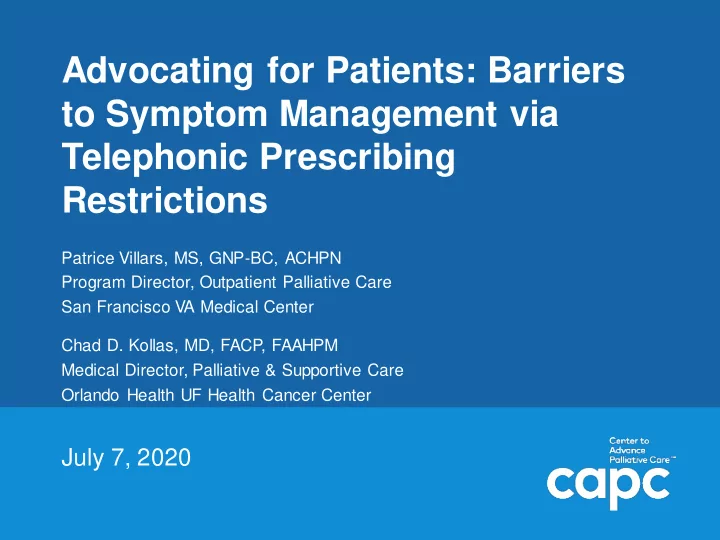

Advocating for Patients: Barriers to Symptom Management via Telephonic Prescribing Restrictions Patrice Villars, MS, GNP-BC, ACHPN Program Director, Outpatient Palliative Care San Francisco VA Medical Center Chad D. Kollas, MD, FACP, FAAHPM Medical Director, Palliative & Supportive Care Orlando Health UF Health Cancer Center July 7, 2020
COVID-19 Pandemic ➔ To mitigate the risk of spreading the COVID-19 infection, many healthcare systems turned to telemedicine to allow for continuity of medical care without an in-person encounter ➔ CMS and other health insurers quickly responded to reimburse telemedicine encounters, including both telephone only and audiovisual encounters 2
Telemedicine ➔ Definition: Communicating with the patient or healthcare professional who is treating the patient using a telecommunications system ➔ The telecommunications system must include audio and video equipment that permits two- way, real-time communications between a patient and a remote practitioner 3
Ryan Haight Act of 2008 ➔ Full Title: Ryan Haight Online Pharmacy Consumer Protection Act (PL-110-145) ➔ Passed October 15, 2008 ➔ Why was it passed? – Amended the Controlled Substance Act of 1970 – It was intended to prevent illegal distribution and dispensing of controlled substances via the internet 4
The Ryan Haight Act’s Effect ➔ Created rules for prescribing controlled medications during a telemedicine encounter ➔ A patient could receive controlled medications if – The patient was being treated by and located in a DEA- registered hospital or clinic and seen within 24 months – By a practitioner “acting in the usual course of professional practice” in “accordance with applicable state law” and registered in the state in which the patient is located (VA & IHS Emergency exceptions) 5
DEA Guidance during COVID-19 ➔ How to prescribe controlled pain medications during the COVID-19 Pandemic 6
Technology is not available or accessible to all ➔ One-third of elderly live alone (USA census 2010) ➔ Ten percent of elderly live in poverty ➔ Shelter-in-place precludes access to obtaining video equipment ➔ Traditional phone often only communication device ➔ Limited internet access if rural communities ➔ Hospice care is not available in all rural communities 7
A Technology Problem: Case 1 ➔ A patient is discharged to home hospice in rural Northern California in the setting of the COVID-19 Pandemic. The patient has an at- home, face-to-face visit with a nurse practitioner from the hospice to establish care. ➔ Subsequently, the patient experiences worsening pain related from their terminal illness and contacts the hospice for adjustments in controlled pain medications. The patient lacks WiFi and is unable to participate in an audiovisual encounter with the hospice medical director, who has never encountered the patient face- to-face . The hospice medical has never directly visualized the patient before ➔ In their current form, DEA telemedicine rules may prohibit the hospice medical director from prescribing a change in the patient’s controlled pain medications 8
A Technology Problem: Case 2 ➔ In the setting of the COVID-19 Pandemic, a patient established with oncologists at a cancer center develops symptoms that would be amenable to management through an outpatient palliative care clinic. ➔ Because of immunosuppression, the patient wants this encounter to occur virtually, while staying as his or her home. ➔ In March 2020, the DEA waived its “DEA Facility” requirement, but the absence of visual component might cause reluctance for prescribing controlled medications without an in-person encounter (initial video consults are permitted, however, but may be technically challenging) 9
A Technology Problem: Case 3 ➔ Elderly patient with dementia, advanced Parkinson’s is referred to outpatient palliative care. He is bedbound, not eating or talking, with strong desire to stay and die at home. CG is elderly wife. ➔ They live is rural area that hospice does not cover. Internet access is unreliable. Local contact not available to help due to shelter in place orders ➔ Unless a patient can be seen via telemedicine at least once, he cannot be prescribed opioids. Options for distressful breathing or pain are to call local emergency services (in overburdened hospital where wife would not be allowed to be with him) or potentially die poorly at home. 10
Our Argument ➔ The COVID-19 Pandemic has created an exception to “acting in the usual course of professional practice” ➔ Impaired access to technology allowing for audiovisual encounters should not create a barrier to receiving palliative care ➔ We call for a temporary policy allowing for wider latitude in prescribing controlled pain medications in these circumstances when done in good faith 11
Questions? 12
Recommend
More recommend